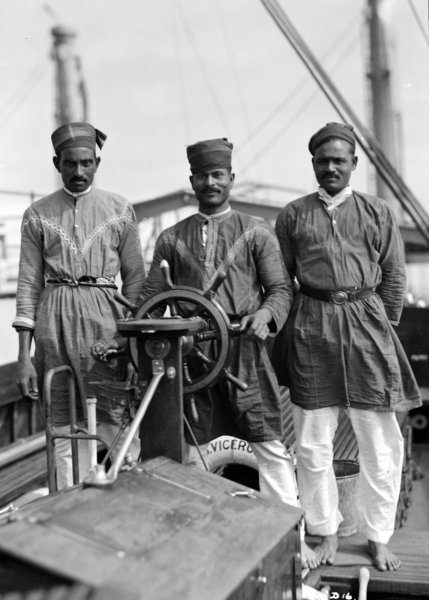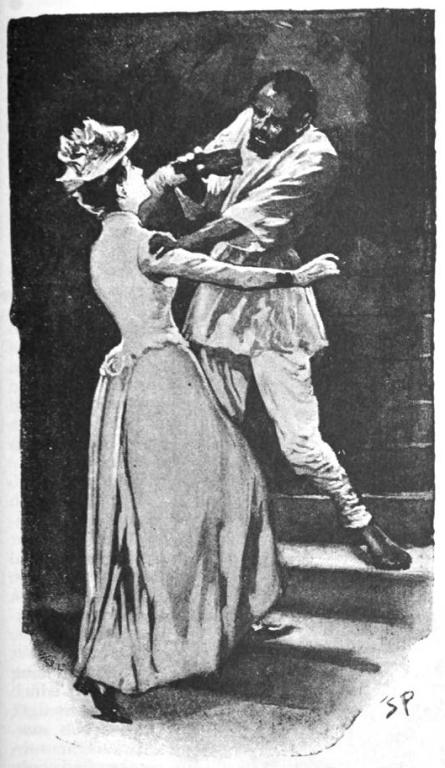As empires spread around the world, they carry with them ideas and institutions, and terminology, usually with no intent of doing so. From the nature of imperial rule, military forces are a great vehicle for such themes, or memes, if you like. Witness how bagpipes survive and flourish in a great many armies across Africa and Asia, pretty much wherever the British army of old made its presence felt (and heard, loudly). Last time I discussed how the Turkish idea of janissary soldiers arrived in the American southwest, together with the appropriate word form, genízaro. Often – not always – such unintentional transmissions have religious implications. As quite humble people travel within empires, they carry words, and faiths, in their baggage.
One word in particular illustrates these linguistic evolutions over time through successive imperial orders spanning continents. This is the word that variously appears in British English, in strongly imperial contexts, as lascar and askari. The history of the word traces some powerful themes in the story of Islam, and its relationship to empire.
The Persian word lashkar meant army, and lashkari signified soldier. During the great Mughal Empire, that word entered India, where it became firmly part of the Urdu language. When the Portuguese borrowed the word during their Indian encounters, it became lascari. The word then applied to sailors mainly hired in the Indian subcontinent, who served around the world for multiple European empires. During the nineteenth century, other lascar seamen were enlisted in Somaliland or the Arabian peninsula, particularly Yemen.
Lascars remained a global phenomenon from the seventeenth century through the mid-twentieth. As to the numbers involved, I quote:
By 1914, lascars made up 17.5 per cent of the total number of mariners manning British registered ships – some 51,000 men. Employed on ‘Asiatic Articles’ as opposed to ‘European Articles’, which defined their conditions of employment, lascars were paid less than European sailors by the shipping industry, which could make large savings by using lascars to increase their profits. At times, whole crews consisted of lascars. And, across many fleets, their treatment on board ships was harsh.
Lascars were thought to be fitted for the brutally hot work of steamship engine rooms, which was unacceptable for Europeans. No Whites need apply (or would ever want to do so).
Lascars became a standard fixture of the imperial worlds of Kipling or Conrad. They also featured in racial mythologies as Sinister Oriental Villains, and pulp novelist Sax Rohmer regularly listed them among the fanatical Asian legions serving Dr. Fu Manchu. We even find evil lascars in the Sherlock Holmes stories of Conan Doyle, who normally knew better about racial stereotyping. See for instance his brutal “Lascar scoundrel” in an opium den in The Man With the Twisted Lip (1891).
Lascars were mainly, if not necessarily, Muslim by faith, and they spread Islam to many corners of the world, especially to Western seaports. In Britain, for instance, one of the oldest Muslim communities is in the great port of Cardiff, with its global connections. The ethnic roots here are Yemeni, and lascar.
But different kinds of lashkari had other uses for European empires. In Arabic, Swahili, and Somali, the loanword askari meant a soldier. As European empires spread, they enlisted large numbers of local Africans to fight for them. Askari soldiers and police became a standard component of European rule in Africa, for the British above all, but also for the Germans, Belgians, Italians, and Portuguese. In the First World War, huge numbers of those African askaris died in the service of the various empires.
Askari forces traveled widely within Africa, very far from their homelands, and they acquired new ideas, and often new religions. They became a major force for cultural and religious diffusion, and especially the spread of Christianity within Africa.
A hundred years ago, if you traveled the world ruled by European empires, you very often saw those askaris and lascars. We note again that it was a Persian military term that achieved this astonishing global reach.
Matters of course changed utterly with the end of those European empires. Within the Islamic world, the notion of a holy Islamic “Army” with its warriors has become notorious. The best known “Lashkar” in the modern world is the Lashkar-e-Taiba, Army of the Righteous (LeT), which was originally designed to combat the “imperial” occupation of Afghanistan by the Soviets. LeT has subsequently been responsible for some of the deadliest mass terror attacks in the Indian sub-continent.
We continue to live in the aftermaths of empire – ethnic, linguistic, and religious.















